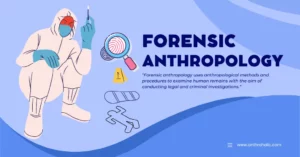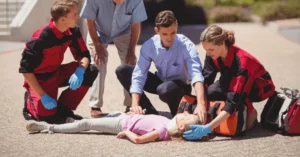AI Answer Evaluation Platform Live Now. Try Free Answer Evaluation Now
Branches of Forensic Science
Forensic Science is an interdisciplinary science that involves the exploitation of various general and applied fields of science. It involves the application of knowledge of basic sciences in the arena of crime and crime scene for the purpose of investigation and administration of justice in the court of law. The goal is to provide reliable evidence that can approve the commission of crime and guilt of the criminal, along with disapproving the presence of an innocent person and the way in which the victim was victimised.

To make this goal of providing evidences as a proof involves a lot of searching and examination of various evidence material with utter precision, so to make sure that the precision is not lost and the evidence are not mixed it was divided into various branches depending upon the nature of the evidence like if the evidence is biological fluids or other biological material it will be dealt in Forensic Biology branch and if the evidence material is a firearm or bullet it will be dealt in forensic ballistic division and so on. Some of the most common Branches of Forensic science are:
1. Forensic Biology and Serology
Out of the many branches of forensic science, biology is the most talked about and plays a cardinal role in criminal investigation. It deals with biological body fluids such as blood, semen, saliva, urine, and other biological evidence such as tissue, muscles, bone, hair, nails, pollen, diatoms, insects, wood etc. It involves various chemical tests such as colorimetric analysis and crystallisation tests along with high end tools and techniques such as spectrometry and transmission electron microscope.
2. Forensic Chemistry
Forensic Chemistry deals with evidence such as adulterated food and liquors, evidence related to petroleum and its products in cases of arson and adulteration, evidence related to explosion and explosive materials. Evidence material such as adulterated alcoholic beverages, non alcoholic beverages, carbonated beverages, fruit juices, adulterated drugs of abuse, petrol, diesel, explosive material such as gunpowder, RDX, PETN, HMX, Nitroglycerine,nitrocellulose, fuses, sulphur oxides, cordite sticks etc are examined under this Branch of forensic science.
3. Forensic Physics
Forensic physics branch of forensic science deals with trace evidences that are physical in nature such as fibres, glass, toolmarks, paint and paint chips, cement, and other building materials, soil, restoration of serial number, chassis number, gait pattern , shoe print, foot print etc.Such evidences are mainly collaborative in nature.
4. Forensic Toxicology
After forensic biology, forensic toxicology is one of the most used branches of forensic science to solve a criminal case. It involves evidence materials that we come across in the cases of poisioning, drug intoxication or overdose, suicide due to intake of any material, death to unnatural circumstances etc. Here we analyse viscera, blood, urine, contaminated food and beverages, intoxicants, drugs, medicine etc.
5. Forensic DNA Fingerprinting
Among the branches of forensic science this is the most important, reliable and widely used branch.It helps in individualization of the evidence material that is biological in nature.Cases related to establishment of identity, parentage testing, unidentified body, mass murder, badly decomposed body or skeletonized body, skeletal remains, sexual assault etc are dealth with the help of DNA fingerprinting branch.
6. Forensic Medicine
This branch of forensic science mainly deals with the questions such as the cause of death, time of death , postmortem changes , wounds and injuries. The postmortem examination and report is the basic expertise of this branch of forensic science. Most of the hospitals have a branch of forensic medicine and it requires a specialised doctoral degree in forensic medicine to be an expert.
7. Forensic Anthropology
Forensic Anthropology deals with the anthropological evidence such as skeletal remains , skeletonized body or just some parts of bone. It helps in estimating the origin (human / non human), age, gender, race, height, any skeletal injury, medical history etc of the skeletal remains. The sub branch of forensic anthropology i.e Forensic Odontology also helps in individualisation using evidence such as teeth, bite marks etc. Reconstruction of the face is also done using superimposition of the skeletal remains of the skull or full skull with the help of high end softwares.
8. Questioned Document
Questioned document deals with the suspicious forms of documents that are in question. This branch helps in solving both civil and criminal cases. Questioned documents such as a forged signature, counterfeit currency, suicide letters, anonymous letterrs, forged passport, financial documents, burnt document, printed or xeroxed document, ink and paper are dealth in this branch. Handwriting analysis and examination is a broad sub branch of this branch.
9. Fingerprint Branch
Fingerprint is the second most reliable evidence that has high evidentiary value in forensics after DNA. No two individuals can have the same fingerprints, not even twins. The fingerprints discovered at the crime scene could be either full or partial , latent, patent and plastic in nature that are first developed for visualisation and then photographed and then finally collected using various fingerprinting methods and techniques depending on the surface on which it is found. The sample fingerprints are also collected from the people involved. Palm prints are also sometimes considered as collaborative evidence if found at the crime scene.
10. Forensic Ballistic
The branch of forensic ballistics deals with the firearms such as pistols; revolvers; rifles etc, ammunition such as bullet; primer; propellant; pellets and wads, fired bullets and cartridge case, gunshot residue, improvised firearms, country made firearms, marks on ammunition such as pin mark; breach face mark etc, and Gun- shot wounds.
11. Forensic Psychology
Forensic psychology is one of the most interesting branches of forensics and it deals with the interrogative and counselling part of the people involved in the crime like the culprit, victim, witnesses etc. Tests such as Polygraph i.e lie detection, Narco Analysis, Brain Fingerprinting etc are utilised in the investigative procedure. Other psychometric tests, projective psychological tests such as the Rorschach test are also done. Psychological post traumatic stress disorder counselling is also done of the victims.
12. Digital Forensic
This branch of forensic science is one of the most important branches nowadays, as due to digitalization most of the crimes have its traces in digital and electronic form. The cyberspace has also been infiltrated with criminals and crimes that makes the digital forensic branch a crucial one. The electronic evidence material such as electronic devices ( laptop, PC, Cellphone, tabs, router etc) are first identified and then acquired, processed, and analysed. Finally the data recovered is reported in the form of digital evidence. Cyber crimes such as phishing, malware attack, pornography, stalking etc are also dealt in the sub branch of digital forensic i.e Cyber Forensics.
13. Forensic Accounting
It is one of the novel branches of forensic science. It deals with the financial and accounting records that becomes a form of evidence when a financial fraud or crime is committed in any company, insurance companies and financial institutions.Such kinds of financial frauds and manipulation needs extreme detailed analysis or auditing, and therefore could only be performed by a skillful and reliable forensic accountant. Corporates and financial institutions have started having separate posts for them lately and it has also become a well paid job option.




